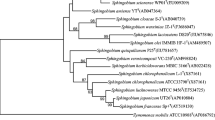Abstract
Objectives
To characterize a novel dimethoate amidohydrolase from Sphingomonas sp. DC-6.
Results
A gene, dmhA, encoding the dimethoate amidohydrolase responsible for transforming dimethoate to dimethoate carboxylic acid and methylamine, was cloned from Sphingomonas sp. DC-6. Sequence analysis and molecular modeling indicate that DmhA shares 31–57 % amino acid sequence identities with other functionally confirmed amidohydrolase. DmhA was expressed in Escherichia coli BL21 (DE3) and purified by Ni–NTA affinity chromatography. The purified DmhA could hydrolyze 4-acetaminophenol, dimethoate and propanil. DmhA activity was optimal at 30 °C and pH 7.5. Hg2+, Zn2+, Cu2+, Cd2+, Tween 80, Triton X-100 or SDS strongly inhibited its activity. The K m and k cat values of DmhA for dimethoate are 0.02 mM and 1.2 s−1, respectively.
Conclusions
DmhA was confirmed to be a novel dimethoate amidohydrolase which could eliminate the toxicity of dimethoate, providing a novel gene resource for the development of pesticide-degrading enzyme preparation and mechanistic study of dimethoate hydrolysis.




Similar content being viewed by others
References
Bottomley MJ, Surdo PL, Di Giovine P, Cirillo A, Scarpelli R, Ferrigno F, Jones P, Neddermann P, De Francesco R, Steinkühler C, Gallinari P, Carfí A (2008) Structural and functional analysis of the human HDAC4 catalytic domain reveals a regulatory structural zinc-binding domain. J Biol Chem 283:26694–26704
Chen Q, Wang CH, Deng SK, Wu YD, Li Y, Yao L, He J, Li SP (2014) Novel three-component Rieske non-heme iron oxygenase system catalyzing the N-dealkylation of chloroacetanilide herbicides in Sphingomonads DC-6 and DC-2. Appl Environ Microbiol 80:5078–5085
Cui ZL, Li SP, Fu GP (2001) Isolation of methyl parathion-degrading strain M6 and cloning of the methyl parathion hydrolase gene. Appl Environ Microbiol 67:4922–4925
Fukuto TR, Metcalf RL (1969) Metabolism of insecticides in plants and animals. Ann NY Acad Sci 160:97–111
Horne I, Sutherland TD, Harcourt RL, Russell RJ, Oakeshott JG (2002) Identification of an opd (organophosphate degradation) gene in an agrobacterium isolate. Appl Environ Microbiol 68:3371–3376
Janknecht R, de Martynoff G, Lou J, Hipskind RA, Nordheim A, Stunnenberg HG (1991) Rapid and efficient purification of native histidine-tagged protein expressed by recombinant vaccinia virus. Proc Natl Acad Sci USA 88:8972–8976
Jiang H, Yang C, Qu H, Liu Z, Fu QS, Qiao CL (2007) Cloning of a novel aldoketo reductase gene from Klebsiella sp. strain F51-1-2 and its functional expression in Escherichia coli. Appl Environ Microbiol 73:4959–4965
Li R, Zheng J, Wang R, Song Y, Chen K, Yang X, Li SP, Jiang JD (2010) Biochemical degradation pathway of dimethoate by Paracoccus sp. Lgjj-3 isolated from treatment wastewater. Int Biodeterior Biodegrad 64:51–57
Lombardi PM, Angell HD, Whittington DA, Flynn EF, Rajashankar KR, Christianson DW (2011) Structure of prokaryotic polyamine deacetylase reveals evolutionary functional relationships with eukaryotic histone deacetylases. Biochemistry 50:1808–1817
Martikainen E (1996) Toxicity of dimethoate to some soil animal species in different soil types. Ecotoxicol Environ Saf 33:128–136
Schäfer S, Saunders L, Eliseeva E, Velena A, Jung M, Schwienhorst A, Strasser A, Dickmanns A, Ficner R, Schlimme S, Sippl W, Verdin E, Jung M (2008) Phenylalanine-containing hydroxamic acids as selective inhibitors of class IIb histone deacetylases (HDACs). Bioorg Med Chem 16:2011–2033
Sogorb MA, Vilanova E (2002) Enzymes involved in the detoxification of organophosphorus, carbamate and pyrethroid insecticides through hydrolysis. Toxicol Lett 128:215–228
Tian F, Liu W, Guo G, Qiang Z, Zhang C (2014) Kinetics and mechanism of dimethoate chlorination during drinking water treatment. Chemosphere 103:181–187
USEPA (2009) Contaminant Candidate List 3- CCL. United States Environmental Protection Agency, Office of Ground Water and Drinking Water, Washington, DC
Zhang J, Yin JG, Hang BJ, Cai S, He J, Zhou SG, Li SP (2012) Cloning of a Novel Arylamidase Gene from Paracoccus sp. FLN-7 that Hydrolyzes Amide Pesticides. Appl Environ Microbiol 78:4848–4855
Acknowledgments
This work was supported by the National Natural Science Foundation of China (31570105), the National Natural Science Foundation of China (J1210056 and J1310015) and the Program for New Century Excellent Talents in University (NCET-13-0861).
Supporting information
Supplementary Figure 1-GC-MS profile of the metabolite produced during dimethoate degradation by strain DC-6. A, GC spectra of the sample collected at 0 h; B, GC spectra of the extract obtained from the culture at 4 h; C and D, charged ions mass spectra for the peak at 8.68 and 9.63 min, respectively. Supplementary Figure 2-SDS-PAGE analysis of the purified DmhA. Lane M, protein markers (kDa); lane A, total protein of Escherichia coli BL21(DE3) harbouring pET-29a(+) as control; lane B, total protein of Escherichia coli BL21(DE3) harbouring pET-29a-dmhA, induced by 0.5 Mm IPTG; lane C, purified DmhA.
Author information
Authors and Affiliations
Corresponding author
Additional information
Qing Chen and Kai Chen contribute equally to this work.
Electronic supplementary material
Below is the link to the electronic supplementary material.
Rights and permissions
About this article
Cite this article
Chen, Q., Chen, K., Ni, H. et al. A novel amidohydrolase (DmhA) from Sphingomonas sp. that can hydrolyze the organophosphorus pesticide dimethoate to dimethoate carboxylic acid and methylamine. Biotechnol Lett 38, 703–710 (2016). https://doi.org/10.1007/s10529-015-2027-6
Received:
Accepted:
Published:
Issue Date:
DOI: https://doi.org/10.1007/s10529-015-2027-6




